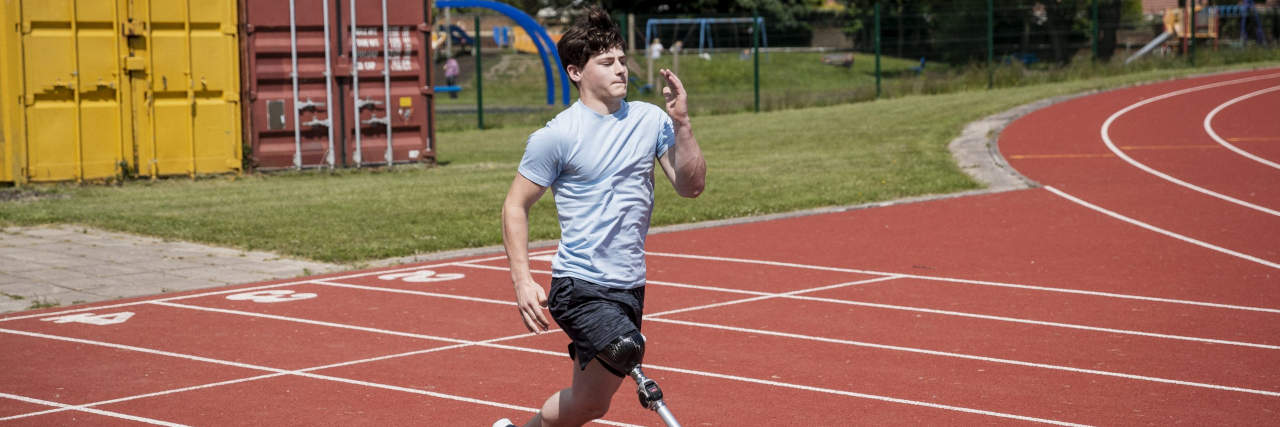“When kindness and inclusion of disabled kids is seen as applause-worthy, it shows how society really feels about disabled people.” – Disabled Feminist via Facebook
This weekend, I saw these words shared atop a post of a blog from a mother of a child with a disability. The child had just been invited to her first-ever birthday party. “Fitting,” I thought.
The day before, I was at a track meet for my nearly-18-year-old twins, and there was a “unified” 100-meter race. Typical “unified” sports teams consist of athletes both with and without disabilities, but my experience is that few athletes without disabilities join these “unified” groups. The word “unified” is often just a sloppy stab at allowing people with disabilities into non-disabled spaces and activities. Last time I checked, though, public schools are for all kids, and this type of event is just another type of segregation that gives children with disabilities the message “You don’t belong.”
Our team was hosting the meet, and it was also Senior Recognition Day. We stood at the 40-yard line — my two sons, my husband, and I — along with about 20 other seniors and their parents who would be announced as soon as the “unified” race ended.
They lined up the “unified” athletes. Their names and schools were broadcast over the sound system, and the crowd ate all of it up — as if somehow these kids had just been elevated to celebrity status simply for being in a race for a few brief moments. Some of the seniors who stood in line with us began to move forward to the edge of the field to cheer the athletes on — then more arrived. I was afraid to look down the line to see only my kids remained back. I looked at one of my boys, and he said, “I don’t know how I feel about this.” Mom taught her boys how to identify ableism well!
I stood there thinking that people in the stands would see us as the only people who weren’t cheering for these kids. But I felt that feeling you get in the pit of your stomach when you know something is wrong, so I just couldn’t cheer. The “unified” race ended. I turned and looked at my husband. “I think I know what I’m going to write about next,” I told him.
“You should. You absolutely should,” he replied. “Let’s see what their times are. I bet they’re not that far off from some of the ‘non-unified’ 100-meter heats. There’s no reason why they can’t run in those.”
I decided to look at the “unified” team’s results when they were posted. I thought it would be interesting to see if their times were faster than some of the kids in the “non-unified” races.
But I never found out because they didn’t post the times for the athletes who ran in the “unified” 100-meter race. They weren’t even listed as competitors on the Mile Split website. I wondered if they even timed the “unified” runners?
Yes, these athletes participated in a track meet, but that in and of itself is not commendable. Instead, these athletes participated in an event in which organizers created a separate “special” event — an “island in the mainstream” if you will. This event was segregation presented as a public display that we were all supposed to be happy about. The underlying message is a telling testament to the beliefs that are largely held by the masses: We’re uncomfortable with differences. If you’re “different,” then you belong in a different place than everyone else.
The Education for Handicapped Children’s Act — which was signed into law in 1975 and later renamed the Individuals With Disabilities Education Act (IDEA) — has created a body of evidence that shows that with inclusive education there are better outcomes for kids both with and without disabilities. School athletic teams are extensions of school and classroom communities. They provide opportunities to learn and grow and prepare youth for life beyond their school years. What are we teaching student athletes when we create separate spaces for athletes with disabilities? How can student athletes with all abilities enrich fellow athletes’ experiences?
What would really be commendable is for the organizers of this “unified” race and others like it to see that there is nothing wrong with bringing kids with disabilities onto the team just like all of the other athletes on the “non-unified” team. At every track meet I’ve witnessed, there are athletes of varying abilities, body physiques, and agility levels. Some athletes aren’t on the path toward college athletic careers. Some students join sports to stay active, to be a part of a team, to have more social interaction, or to belong. At track meets, there are many opportunities for a variety of athletes to participate — not just the top performers.
If given the opportunity for true inclusion on the track field, some of the “unified” athletes might show that they are just as competitive and talented as athletes without disabilities. Of course, just like some of the athletes without disabilities, some might not. However, if this were to happen, all kids might create connections and friendships with each other. All kids might have the opportunity to find a space where they truly belong.
When we no longer have “unified” races, that’s when I’ll stand up and cheer. When I look at a group of athletes on the starting line and witness the true diversity that makes up our schools — athletes with visible and invisible disabilities and athletes without disabilities competing together — I’ll applaud like the spectators at my sons’ race did. Let’s stop creating segregated events for people with disabilities and instead build spaces where we all belong. We know better, so let’s do better.
Getty image by SolStock.

